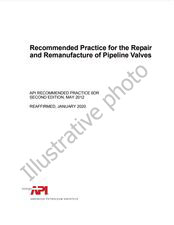We need your consent to use the individual data so that you can see information about your interests, among other things. Click "OK" to give your consent.

API STD 2RD-ed.2
Dynamic Risers for Floating Production Systems
Translate name
STANDARD published on 1.9.2020
The information about the standard:
Designation standards: API STD 2RD-ed.2
Publication date standards: 1.9.2020
SKU: NS-1140492
The number of pages: 91
Approximate weight : 304 g (0.67 lbs)
Country: American technical standard
Category: Technical standards API
Annotation of standard text API STD 2RD-ed.2 :
API STD 2RD, 2nd Edition, September 2013 - Dynamic Risers for Floating Production Systems
This standard addresses riser systems that are part of a floating production system (FPS). Guidelines for design, construction, installation, operation and maintenance of floating production systems (FPSs) are in API 2FPS. A riser is a subsystem in a floating production system.
The provisions of this standard do not apply to the riser systems of mobile offshore drilling units (MODUs).
There is significant interaction among the subsystems in a floating production system. Hull motions affect risers and mooring, and conversely, risers and mooring affect hull motions. Global behavior of the system provides input to assessment of subsystems. Assessment of a subsystem provides feedback (loads) for assessment of the hull and other subsystems.
Determination of the boundaries of a riser system and management of the interactions with other subsystems is the responsibility of the operator.
A riser system is an assembly of components, including pipe and connectors. A riser system can include a riser tensioning system, buoyancy modules, etc. Pipe components can be steel, titanium, or unbonded flexible pipe. Design considerations for unbonded flexible pipe are included primarily by reference to API 17B and API 17J. Design considerations for titanium alloy pipe are included primarily by reference to DNV-RP-F201. Steel and titanium pipe are referred to as rigid pipe and unbonded flexible pipe is referred to as flexible pipe.
All or part of several existing codes, standards, specifications, and recommended practices are included by reference.
Design loads and conditions are described in Section 4. Structural design criteria for rigid pipe are in Section 5. Structural capacity formulae for steel pipe are also in Section 5. Additional requirements for components, including pipe, are in Section 6. Material requirements are in Section 7. Fabrication and installation requirements are in Section 8. Integrity Management is addressed in Section 9.
We recommend:
Technical standards updating
Do you want to make sure you use only the valid technical standards?
We can offer you a solution which will provide you a monthly overview concerning the updating of standards which you use.
Would you like to know more? Look at this page.



 Cookies
Cookies
